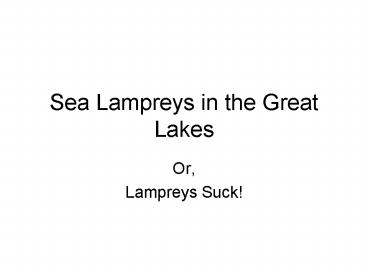Sea Lampreys in the Great Lakes - PowerPoint PPT Presentation
1 / 33
Title:
Sea Lampreys in the Great Lakes
Description:
Sharp decline in L. Michigan trout catches. Wounds and scars appearing on ... a chemical used in the carpet dyeing industry, was found to be selectively toxic ... – PowerPoint PPT presentation
Number of Views:195
Avg rating:3.0/5.0
Title: Sea Lampreys in the Great Lakes
1
Sea Lampreys in the Great Lakes
- Or,
- Lampreys Suck!
2
Signs of a Fishery in Trouble
- Sharp decline in L. Michigan trout catches
- Wounds and scars appearing on larger fishes
- Live lampreys attached to their prey
3
Sharp Decline in Trout Catches
4
Fresh wounds on whitefish
5
Healed scars on larger fish
6
Live lampreys and wounds on lake trout
7
Multiple wounds on larger fish
8
Evidence that Sea Lampreys were the Problem
- Increase in numbers of lampreys caught in the
fisheries - Only the larger fishes were affected
9
Progressive collapse of fisheries in order of
proximity to Niagara Falls
10
Possible Migration Routes to Upper Great Lakes
- Earliest access above Niagara Falls was via the
New York State Barge Canal (Erie Canal) - In 1935 the Welland Canal was expanded to
increase the capacity of Great Lakes shipping
11
Access to Upper Lakes
12
Immediate Management Actions
- Formed the GLFC by treaty between the U.S. and
Canada - Began studying the life history of sea lamprey
- Started to control adult lampreys by physical and
mechanical barriers on spawning tributaries to
the Great Lakes - Established research laboratories on Great Lakes
fisheries in the U. S. and Canada
13
Hammond Bay Laboratory
14
Key Features of Life History
- Adults migrate upstream to spawn on gravel
substrate, then die after spawning - Juveniles hatch and live in streams as ammocoetes
(larval lampreys) filter-feeding until they are
approximately 120mm in length - Ammocoetes transform into predatory (or,
parasitic) forms and migrate downstream into the
lakes - Feeding takes place on fish for period of 12-18
months - Maturing adults migrate back up tributary streams
for spawning
15
(No Transcript)
16
(No Transcript)
17
(No Transcript)
18
(No Transcript)
19
(No Transcript)
20
Sea Lampreys Ready to Spawn
21
(No Transcript)
22
Massive stream surveys were undertaken to
identify lamprey habitat
- Every tributary to the upper Great Lakes was
searched for presence of juvenile sea lampreys - Electrofishing was the favored sampling method
23
(No Transcript)
24
Earliest control methods were mechanical and
electrical weirs and traps
25
Trap-caught sea lampreys
26
Chemical Larvicide Discovered in 1958
- TFM (3-trifluoromethyl-4-nitrophenol) a chemical
used in the carpet dyeing industry, was found to
be selectively toxic to juvenile lampreys
27
Chemical metered into ammocoete streams to kill
larvae
- TFM is effective in killing lamprey larvae (all
species) at concentrations of about 2 ppm. It
also kills certain mayfly and stonefly larvae at
these concentrations. It is lethal to most other
fishes at levels above 4 ppm, and administration
of the chemical is a highly demanding procedure,
fraught with uncertainties such as poor mixing
and dilution due to thunderstorms and spring
seepage.
28
Cumulative Impact of Treatment Catches Several
Year-classes at Once
29
Chemical Control Must be Maintained
30
Larger and most economically valuable fishes
remain vulnerable to sea lamprey predation
31
Limitations on TFM control
- Some streams are virtually untreatable, e.g. the
St. Marys River between L. Superior and Lake
Huron - Environmental costs (especially to invertebrates)
- Single supplier for the compound (until recently)
- Expensive to administer
32
Alternative Control Measures
- Barrier dams
- Combinations with other chemicals (Bayer 73)
- Electrical weirs and traps
- Sterile male controls
33
Hope for Future Control
- After 16 years of research, Dr. P. Sorensen at U
of Minnesota discovers pheromone effective in
attracting mature lampreys - The compound is related to bile acids excreted by
ammocoetes in streams suitable for lamprey
production - The new approach promises to provide a method for
luring wild lampreys to sites suitable for
trapping































